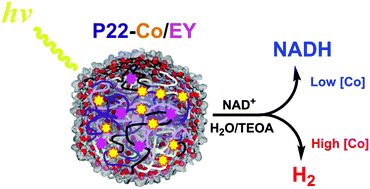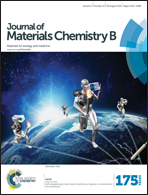Co-localization of catalysts within a protein cage leads to efficient photochemical NADH and/or hydrogen production†
Abstract
Using the interior of the P22 virus-like particle (VLP) we have co-localized and constrained multiple copies of a photosensitizer (Eosin-Y) and a NADH/hydrogen catalyst (cobaloxime). These small molecules were conjugated to an amine bearing polymer framework synthesized within the confines of the P22 capsid by atom transfer radical polymerization (ATRP). Using aminoethyl methacrylate (AEMA) and bis-acrylamide as the monomers we introduced a crosslinked polymer framework with addressable amines and conjugated each of the small molecules through an isothiocyanate moiety. With precise control over the average labeling stoichiometry, we conjugated the Eosin-Y and cobaloxime catalysts to the polymer such that they were co-localized on the interior of the P22 VLP. This co-localization facilitated the photochemical production of NADH from NAD+ under aqueous conditions with a maximum turnover of 11.40 × 10−3 s−1. The reaction products could be switched from NADH to H2 production by increasing the relative stoichiometry of the cobaloxime labeling. The co-confinement of this coupled catalytic system within the VLP P22 creates a nano-material whose turnover activity is independent of the bulk concentration. These constructs are an example of a biomimetic materials design and synthesis approach in which efficient photochemical production of both NADH and hydrogen can be controlled by co-localizing catalysts within a virus-like particle.


 Please wait while we load your content...
Please wait while we load your content...